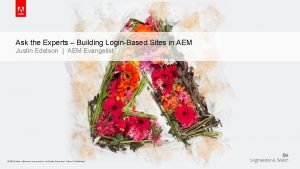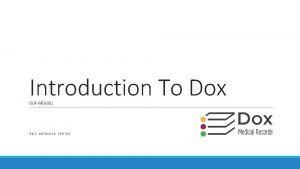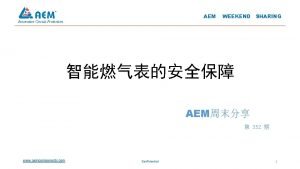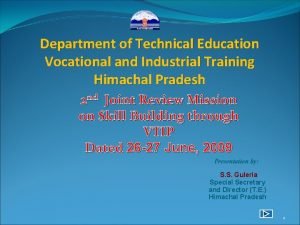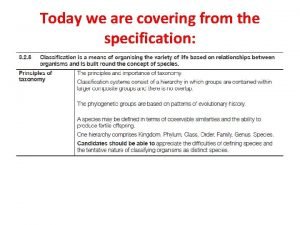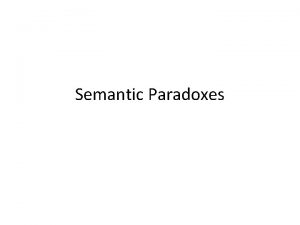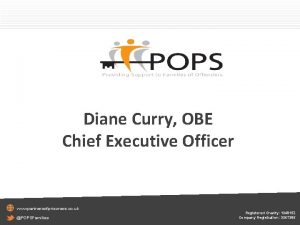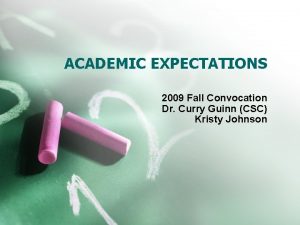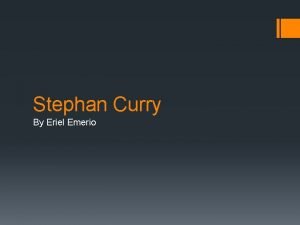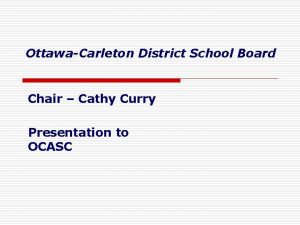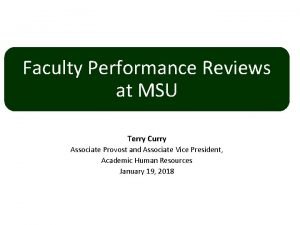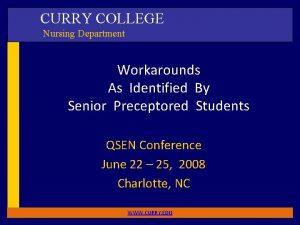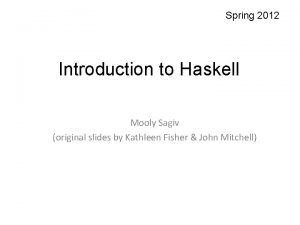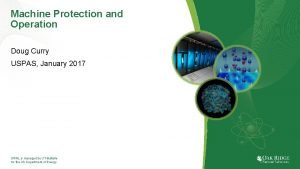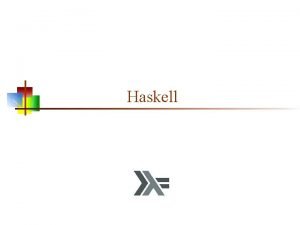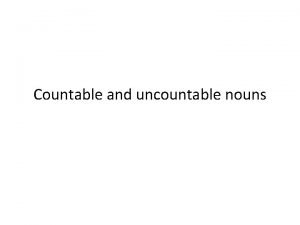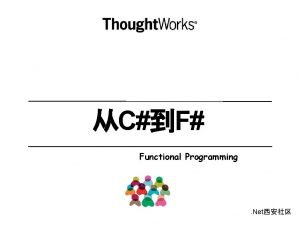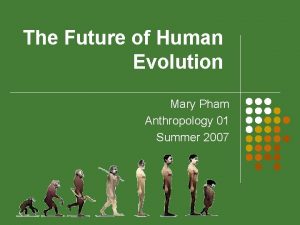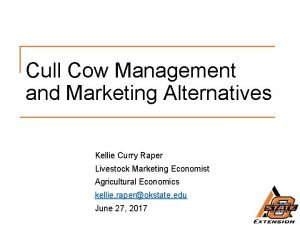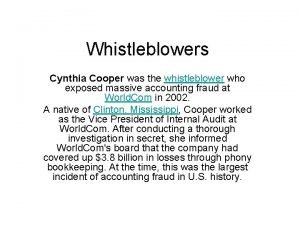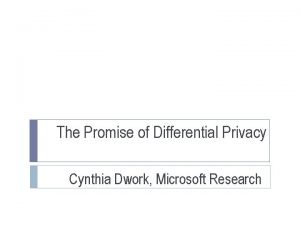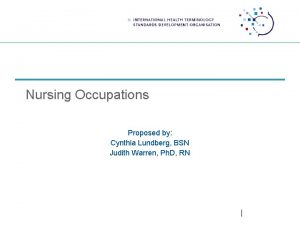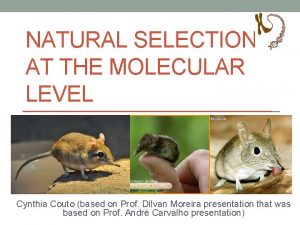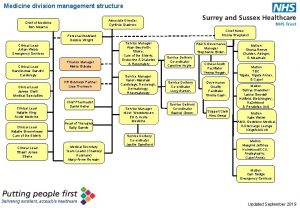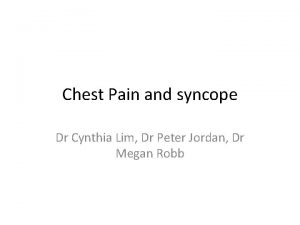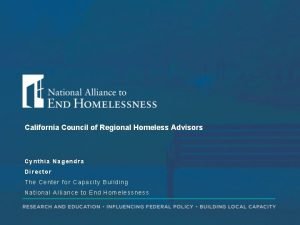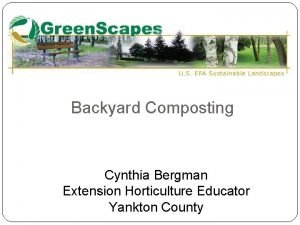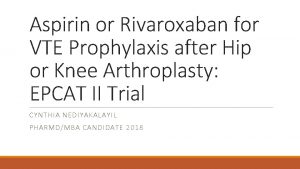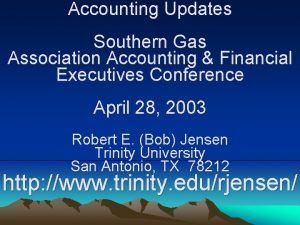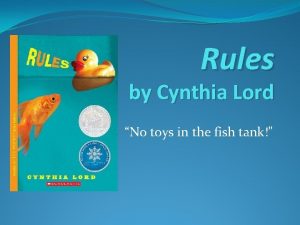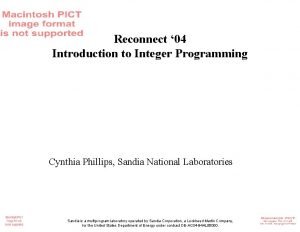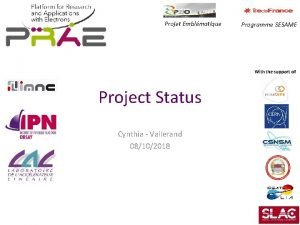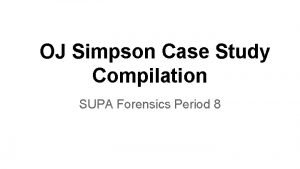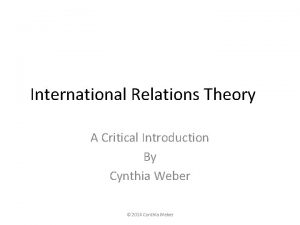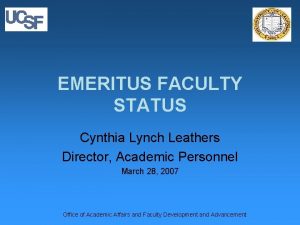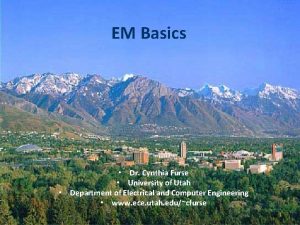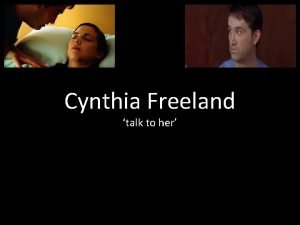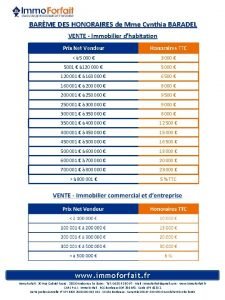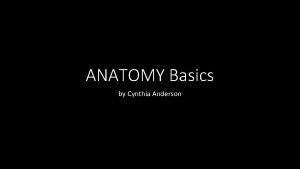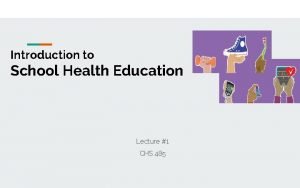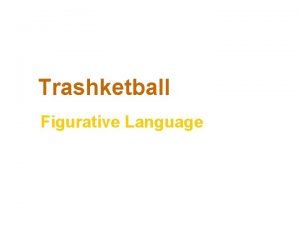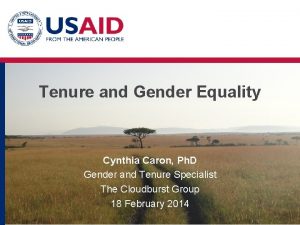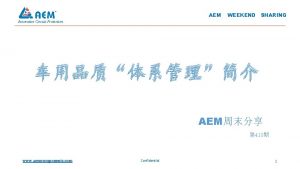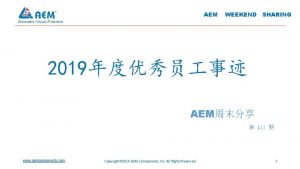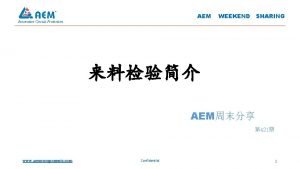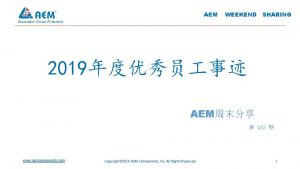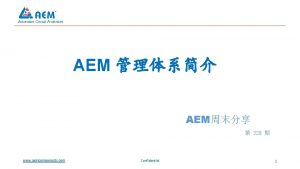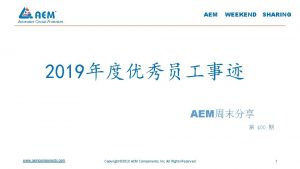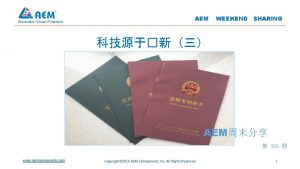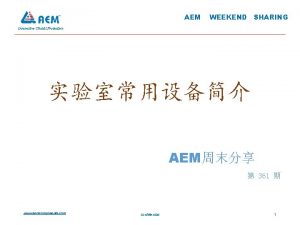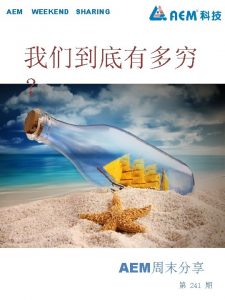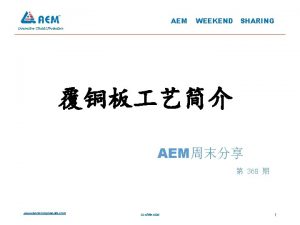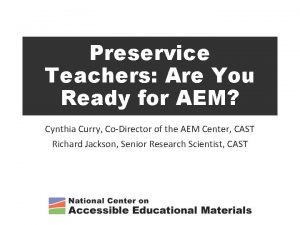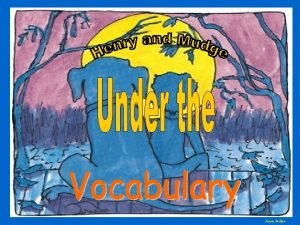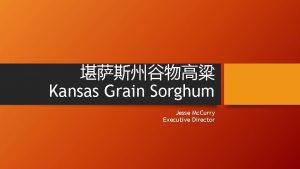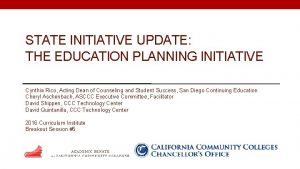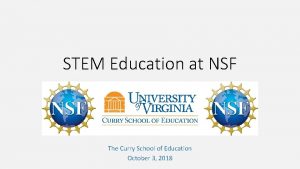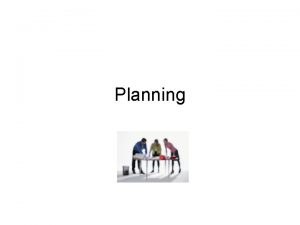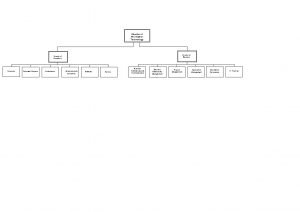AEM in TransitionFocused Education Planning Cynthia Curry Director


























































- Slides: 58

AEM in Transition-Focused Education Planning • Cynthia Curry • Director • National AEM Center

Changes Ahead @AEM_Center 2

For whom are you here today? Someone you know is going to take a big leap. @AEM_Center 3

What is your role in transition-focused planning? • Educator, service provider, family, etc. of learners at which level: • Pre-K • Elementary school • Middle school • High school • Postsecondary • In the chat: • Your role(s) • Which level(s) @AEM_Center 4

Working Backward in the Transition Process 1 st year in HE @AEM_Center Summary of Performance (SOP) Individualized Education Program (IEP) 5

Topics • Differences between special education in K-12 and disability services in postsecondary settings. • Examples of how learners use AEM and accessible technologies to meet higher ed requirements. • Strategies for preparing students to be independent users of AEM and accessible technologies before completing high school. • Notes: • SWD = Students with Disabilities • HE = Higher Education @AEM_Center 6

Current Landscape for SWDs and HE Where HE happens Concerning and promising statistics The power of transition planning @AEM_Center 7

Higher Ed (HE) Destinations • 2 -year community college • 4 -year college or university • Career and Technical Education (CTE) programs (career tech/technical college systems) @AEM_Center 8

Concerning Statistics: Secondary Education Outcomes • 2014 -2015 • HS graduation rate for all students: 83% • HS graduation rate for SWDs: 65% • U. S. DOE, 2016 @AEM_Center 9

Concerning Statistics: Postsecondary Outcomes • SWDs enroll in college at half the rate of their peers without disabilities and graduate at a lower rate -Cited in Lyman et al. , 2016 • Of persons with disabilities aged 25+ • 24. 9% have an associate’s degree vs. 45% of persons without disabilities • 16. 7% have a bachelor’s degree vs. 34. 9% of persons without disabilities • Ryan & Bauman, 2016 • 14% have bachelor’s degree or higher vs. 33% of people without disabilities • Erickson et al. , 2016 @AEM_Center 10

Promising Statistics • Rate of SWDs in postsecondary education has almost doubled since 1995 • 6% in 1995 -96 • 11. 1% in 2011 -2012 • (44% enroll in 2 -yr or community colleges, 32% in CTE schools, 19% in 4 -yr institutions) -Cited in Newman et al. , 2016 @AEM_Center 11

The Promise of Transition Planning Research has shown that SWDs who receive transition planning services in HS and attend HE are more likely to: • Self-disclose their disability earlier • Have higher GPAs • Earn credits by their sophomore year • Receive disability-specific supports • Access supports available to all students -Cited in Newman et al. , 2016 @AEM_Center 12

From Your Point of View Students are being: • effectively prepared • somewhat prepared • not prepared at all for postsecondary learning. @AEM_Center 13

Factors Contributing to the Challenges of the First Year • K-12 – Postsecondary Legislation Differences • Shift in Responsibility • Navigating Accommodations @AEM_Center 14

Legislation Differences • K-12 Laws • Individuals with Disabilities Education Act (IDEA) • Section 504 of the Rehabilitation Act of 1973 (Section 504) @AEM_Center • Postsecondary Laws • Americans with Disabilities Act as amended in 2008 (ADA) • Section 504 15

K-12: IDEA • The nation’s K-12 special education law for children from infancy to HS graduation or age 21. • Requires schools to: • Serve the educational needs of eligible SWDs. • Find and evaluate students suspected of having disabilities-at no cost to families. • Guarantee a free appropriate public education (FAPE) for students with disabilities in the least restrictive environment (LRE). @AEM_Center 16

Postsecondary: ADA Requires HE institutions • Title II – State and local governments to provide SWDs with • Public universities and accommodations that are community colleges necessary to afford the • Title III – Public SWD an equal accommodations opportunity to • Private colleges and participate in the universities institution’s programs. @AEM_Center 17

IDEA-ADA Distinction • IDEA • Student progress and success @AEM_Center • ADA • Equal access 18

Shift in Responsibility: From the Team to the Student • K-12 • Adult team is responsible for developing a program that ensures student progress @AEM_Center • Postsecondary • Student is responsible for requesting and using accommodations for equal access 19

Student Responsibilities • Voluntarily self-disclose a disability to Disability Support Services (DSS) • Request accommodations • Participate in an interactive process to determine reasonable accommodations in the postsecondary setting • Provide documentation • Meet with DSS personnel to discuss the request for accommodations and associated documentation @AEM_Center 20

Barriers to Seeking and Using Accommodations • • Lack of self-advocacy skills Belief that services aren’t needed Desire for self-sufficiency Desire to avoid negative social reactions Insufficient knowledge about services Fear of future ramifications Quality and usefulness of DSS and provided accommodations Negative experiences with faculty -Lyman et al. , 2016 @AEM_Center 21

The Role of Accessible Materials and Technologies in Transition Planning • • Definition of Accessibility Materials and Technologies Assistive Technology Interoperability @AEM_Center 22

Functional Definition of “Accessible” A person with a disability can acquire the same information engage in the same interactions equally effective, equally integrated, with substantially equivalent ease of use enjoy the same services as a person without a disability 23

Accessible Materials & Technologies Accessible Materials Accessible Technologies • Information or content • Designed or enhanced in a way that makes them usable by the widest possible range of learner variability regardless of format • Print, digital, graphical, audio, video • Hardware of software that delivers material • Usable by people with a wide range of abilities and disabilities • Directly usable without assistive technology (AT) or usable with it • accessibletech. org 24

Material-Technology in Accessible Harmony Students read accessible ebooks on accessible tablets with built-in options for access: • Screen reader • Text to speech • Display customization • Bluetooth-enabled • Closed captions • Video description 25

Interoperability: Material - Technology - AT 26

AEM-Related Postsecondary Accommodations • Alternative formats of printed textbooks and inaccessible digital materials • Use of AT • Extended time on exams • Note taking services • Audio recording of lectures @AEM_Center 27

AEM Tools That Increase Student Independence in HE • Accessible digital versions of textbooks and course materials at commercial sources (Amazon, Audible, Vital. Source, the college bookstore) • Membership services: Bookshare and Learning Ally • Text to speech • Optical Character Recognition (OCR) apps • Audio recording apps • Smart pens • Note taking apps @AEM_Center 28

AEM in Transition Planning • Definition • A Successful Model @AEM_Center 29

Timeline of Transition Requirements in IDEA • 1975 - Education for All Handicapped Children Act • 1990 - Requires transition planning for SWDs beginning at age 16 • 1997 - Requires transition planning begin at age 14 with a statement regarding course of study and at ≤ 16 a statement regarding needed services, including outside agencies • 2004 - Requires Summary of Performance (SOP) @AEM_Center 30

IDEA Definition of Transition Planning • A coordinated set of activities for a child with a disability • Results-oriented • Based on individual needs, taking into account strengths, preferences, and interests • Includes instruction, related services, community experiences, employment, etc. [34 CFR 300. 43] @AEM_Center 31

Definition of “Transition. Focused Education” • Transition planning is • A fundamental basis of education that guides the development of all educational programs-including strategies that keep them in school • Not an “add-on” activity for SWDs • Based on abilities, options, and self-determination -Cited in Kohler & Field, 2003 “A shift from disability-focused, deficit-driven programs to an education and service-delivery approach based on abilities, options, and selfdetermination. ” @AEM_Center 32

Implementing Transition. Focused Education @AEM_Center 33

@AEM_Center 34

Summary of Performance (SOP) and the Individual Education Program (IEP) • In IDEA • Model Template @AEM_Center 35

SOP in IDEA • IDEA 2004 Sec. 300. 305(e)(3) • For a child whose eligibility under special education terminates due to graduation with a regular diploma, or due to exceeding the age of eligibility, the local education agency “shall provide the child with a summary of the child’s academic achievement and functional performance, which shall include recommendations on how to assist the child in meeting the child’s postsecondary goals. ” • Must be completed during the final year of HS. @AEM_Center 36

@AEM_Center 37

Sections of the SOP Model Template 1. 2. 3. 4. 5. Background Postsecondary Goals Summary of Performance Recommendations Student Input @AEM_Center 38

Sections of the SOP Model Template for AEM 1. 2. 3. 4. 5. Background Postsecondary Goals Summary of Performance Recommendations Student Input @AEM_Center 39

Summary of Performance: Academic Area @AEM_Center 40

Summary of Performance: Academic Area: AEM Use of text to speech tools for reading and writing support Use of speech recognition Books provided in specialized formats Accessible formats of classroom materials Audio recording of class lectures @AEM_Center Use of digital study skills tools 41

Recommendations @AEM_Center 42

Recommendations: AEM Be as specific as possible about AEM and accessible technology -related accommodations @AEM_Center 43

Student Input @AEM_Center 44

OH Packet: SOP Form, Guidance, Sample Cover Letter, Resources @AEM_Center 45

AEM in the IEP • AEM in the IEP: Where Do Accessible Materials and Technologies Fit? • AEM Center webinar by Joy Zabala and Diana Carl recorded May 1, 2018 • Link in the digital handout @AEM_Center 46

Final Recommendations • • Set High Expectations. And Provide AEM for Reaching Them. Give Students a Record of AEM Use Explain Documentation to Students Provide (lots of) Opportunities to Use AEM Give Students an Active Role in AEM-Related Decisions Teach Self-Determination Skills Foster Family Engagement @AEM_Center 47

Set High Expectations. And Provide AEM to Reach Them. • Ensure IEP goals are aligned with challenging academic content standards for the grade in which a student is enrolled. • Research findings: • SWDs who took rigorous HS academic courses were more likely to enroll in college, earned more college credits, had higher college GPAs, and were more likely to earn a bachelor’s degree • SWDs who took more gen ed classes were more likely to be actively involved in their transition planning -Cited in Newman et al. , 2016 • Provide students with the AEM and accessible technologies they need to reach those high expectations. @AEM_Center 48

Give Students a Record of AEM Use • IEP • Make clear the connection between the need for accessible materials and technologies and annual goals. • SOP • Make the need for accessible materials and technologies explicit in the Summary of Performance, Recommendations, and Student Input. @AEM_Center 49

Explain Documentation to Students Prepare students to discuss their evaluation results or physical records with DSS personnel: • Neuropsych or psychoeducational evaluation reports • Medical records (MD, PT, OD, etc. ) @AEM_Center 50

Provide (lots of) Opportunities to Use AEM • Across • Purposes • Content areas • Environments • Technologies • Materials @AEM_Center 51

Give Students an Active Role in AEM-Related Decisions • Conduct trials of formats and features • Have input on related goals and services • Be empowered to self-evaluate and communicate effectiveness over time • Actively contribute to AEM in transition plans and their SOP @AEM_Center 52

Teach Self-Determination • Independent access and use of accessible materials and technologies • Ability to articulate need @AEM_Center 53

Foster Family Engagement • Involve, empower, and prepare families (from Taxonomy for Transition Programming 2. 0) • Communicate effectively and share information • Develop collaborative partnerships • Connect families with one another (by request) • Show genuine care for and recognition of children @AEM_Center 54

Conclusion Transition to adult roles is a complex process all youths must negotiate and that a myriad of factors work together to influence students’ lives after school completion. -Kohler & Field, 2003 @AEM_Center 55

Contact Information Cynthia Curry ccurry@cast. org @clcurry 56

Thank you! Please take a moment to complete our webinar evaluation. https: //www. surveymonkey. com/r/Transition 0518 @AEM_Center 57

The contents of this webinar were developed under a cooperative agreement with the US Department of Education, #H 327 Z 140001. However, those contents do not necessarily represent the policy of the US Department of Education and you should not assume endorsement by the Federal Government, Project Officer, Tara Courchaine, Ed. D. @AEM_Center 58
 J_security_check aem
J_security_check aem Aem dox
Aem dox Aem wknd
Aem wknd Director of technical education hp
Director of technical education hp King prawn curry or fat greasy sausages
King prawn curry or fat greasy sausages Bean costume
Bean costume Barbers paradox
Barbers paradox Philip curry business
Philip curry business Leaving cert business philip curry
Leaving cert business philip curry Diane curry
Diane curry Curry guinn
Curry guinn Stephan curry biography
Stephan curry biography Cathy curry
Cathy curry Charles curry austin tx
Charles curry austin tx Curried function haskell
Curried function haskell Spook bridge
Spook bridge Terry curry msu
Terry curry msu Curry absn
Curry absn Haskell curry
Haskell curry Doug curry
Doug curry Haskell
Haskell Plurals worksheet
Plurals worksheet C# curry
C# curry Pirates of the curry bean costumes
Pirates of the curry bean costumes Gina curry
Gina curry Mary pham
Mary pham Kellie curry
Kellie curry Cynthia cooper accountant
Cynthia cooper accountant Cynthia dwork differential privacy
Cynthia dwork differential privacy Critical period vs sensitive period
Critical period vs sensitive period Stray plot diagram
Stray plot diagram Cynthia hale birthday
Cynthia hale birthday Cynthia lundberg
Cynthia lundberg Cynthia couto
Cynthia couto Dr cynthia quainoo
Dr cynthia quainoo Family tree princess diana
Family tree princess diana Cynthia goddess of the moon
Cynthia goddess of the moon Cynthia gatewood
Cynthia gatewood Cynthia lim md
Cynthia lim md Cynthia nagendra
Cynthia nagendra Cynthia bergman
Cynthia bergman Cynthia nediyakalayil
Cynthia nediyakalayil Cynthia cooper (accountant)
Cynthia cooper (accountant) Rules by cynthia lord read aloud
Rules by cynthia lord read aloud Cynthia freeland football
Cynthia freeland football Matrice iac
Matrice iac Cynthia shahian
Cynthia shahian Cynthia santamaria
Cynthia santamaria Cynthia weber international relations theory
Cynthia weber international relations theory Dr cynthia lynch
Dr cynthia lynch 8 854x10^-12
8 854x10^-12 Cynthia freelund sexy
Cynthia freelund sexy Cynthia švrlingová
Cynthia švrlingová Cynthia baradel
Cynthia baradel Vertebral cavity
Vertebral cavity Cynthia agustin
Cynthia agustin Introduction of school health services
Introduction of school health services Trashketball rules
Trashketball rules Cynthia caron
Cynthia caron
